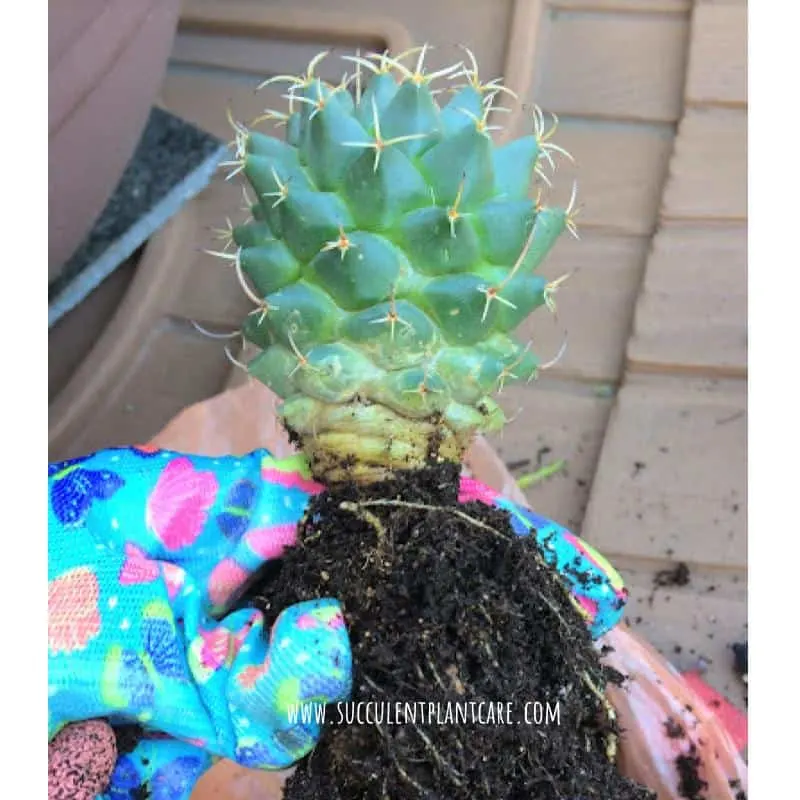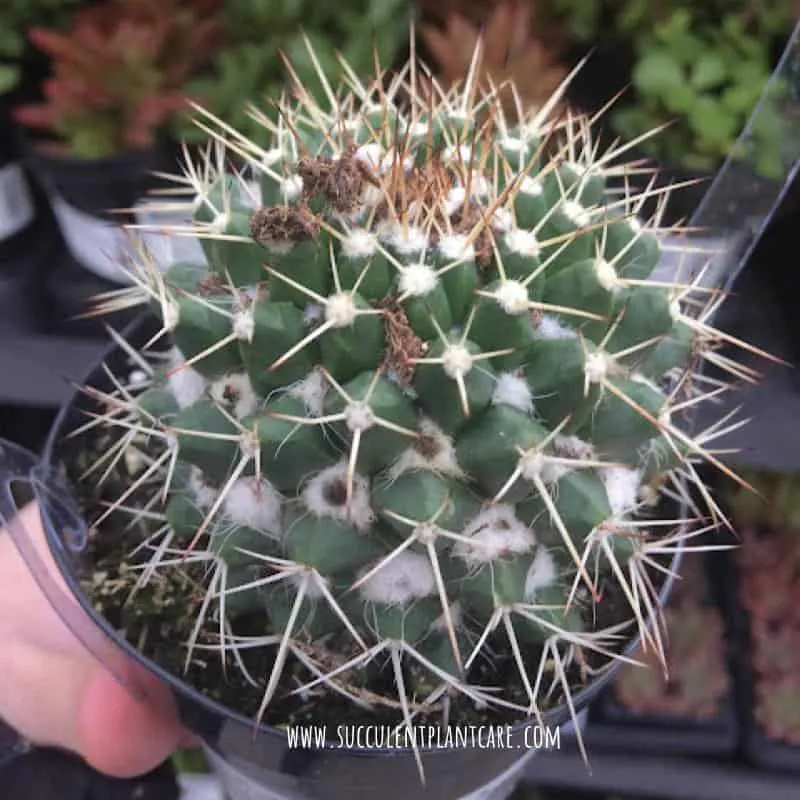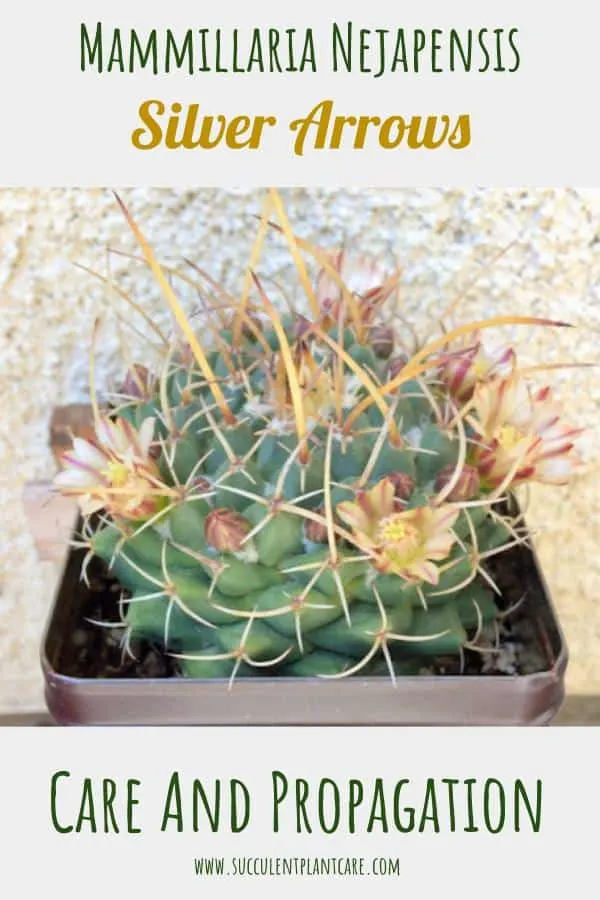Scientific Name: Mammillaria Karwinskiana subs. Nejapensis
Mammillaria Nejapensis, also known by its common names “Silver Arrows” and “Royal Cross” is a popular flowering cactus plant that belongs to the Cactaceae family. This cactus is native to Oaxaca, Mexico. It forms globular stems with silvery-white, sharp spines. White woolly bristles are found on the areoles. It can grow up to around 6-8 inches (15-20 cm) tall. Solitary at first, then the stem branches dichotomously to form two stems until large clusters are formed. It produces light yellow and cream flowers with magenta-pink stripes that can be numerous and surround the plant.
Mammillaria nejapensis is not hard to care for and grow. Learn about care and growing tips right here.

Is the Mammillaria nejapensis an Indoor or Outdoor Plant?
For the most part, Mammillaria nejapensis is known as an outdoor plant but can be grown indoors too. Mammillaria nejapensis does very well outdoors where it can get the sunlight that it needs. If you must grow your plant indoors, provide some outdoor time for it during the warmer months if possible and it will benefit from it. Whether grown indoors or out, the most important things to consider is to provide adequate sunlight, a well-draining potting mix, and enough but not too much water.
Indoor Lighting Requirements
If you are growing this particular plant indoors, you will need to pay special attention to how much light it gets. Choose the brightest spot in the house to place your plant. A south-facing window is a perfect spot for a cactus of this type. East and west-facing windows will also work.
Window spots are generally sunnier than other positions in the house because they receive the most sunlight from outdoors. At the same time, window spots are also cooler than other locations in the house during the colder months because of the draft coming from outside. When choosing where to place your plant, don’t hesitate to move the plant around a few times until you find the best spot for it.
Generally speaking, Mammillaria nejapensis needs approximately 5-6 hours of sunlight a day to thrive. If you can’t provide adequate sunlight indoors no matter where you place the plant, consider using a grow light. Grow lights can help supplement the lighting needs of your plant, particularly during the long, dark winter months. Here are some of my grow light recommendations. Also, providing some outdoor time in the warmer months will be good for the plant.
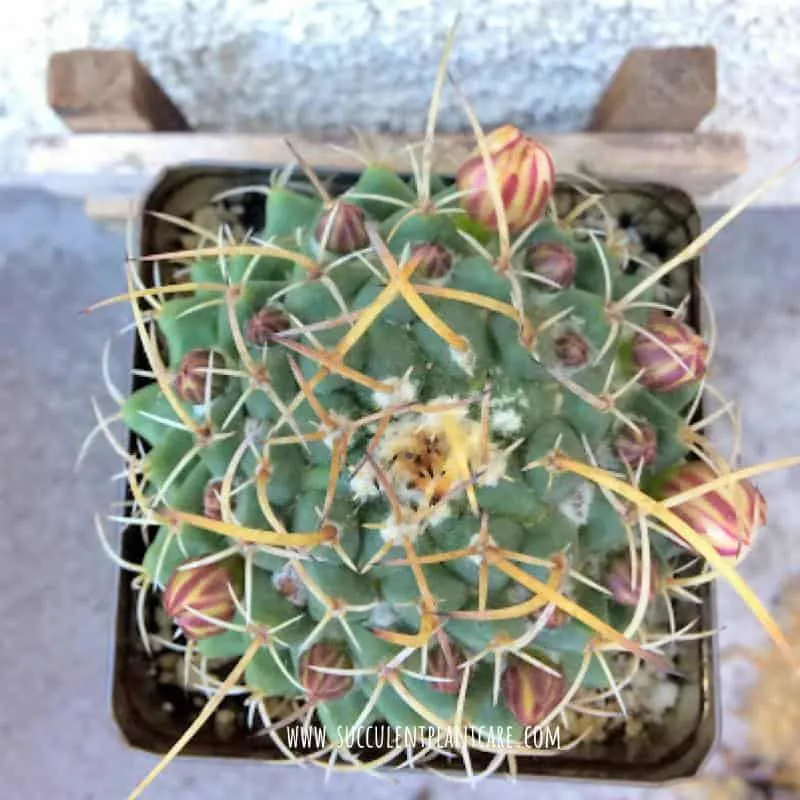
Outdoor Sunlight Requirements
Mammillaria nejapensis can tolerate partial shade to full sun. This plant will do very well when exposed to plenty of sunlight. However, it will not do very well under direct sunlight during extremely hot days for an extended period of time, especially for smaller, younger plants.
Acclimate your plant to full sun or direct sun before completely exposing it to very intense heat. Bright, partial shade during the hottest time of the day is best while acclimating the plant to the heat. You can position your Mammillaria nejapensis in a sunny spot with afternoon shade and it should be perfectly happy.
During a heatwave or intense heat, the plant may suffer from sunburn or sun damage. To prevent this from happening, move the plant to a shadier location during a heatwave. You can also provide sunshades during really hot summer days and extreme heat waves when the temperature can scorch most of your succulent plants. Here are some of my sun shade recommendations.
Frost Tolerance
The Mammillaria nejapensis can be fairly frost resistant, especially if you keep it dry in the wintertime but only up to a certain point. Mammillaria nejapensis is frost tolerant up to around 23 °F or -5 °C, with a bit of frost. To ensure survival during frost, the plant needs to stay relatively dry and needs to receive adequate sunlight during the day to warm it up.
For people living in climates with harsh winters, the best way to grow this plant is in containers. That way you can bring it indoors or move it to a warmer location to protect it from freezing temperatures. If you can’t bring the plant indoors during the winter months, you can protect it by using frost cloths for greenhouses. Here are my frost protection recommendations.
The plant goes dormant during the cold winter months, so don’t expect a lot of growth to happen around this time. Its real growing season is during the spring and summer months.
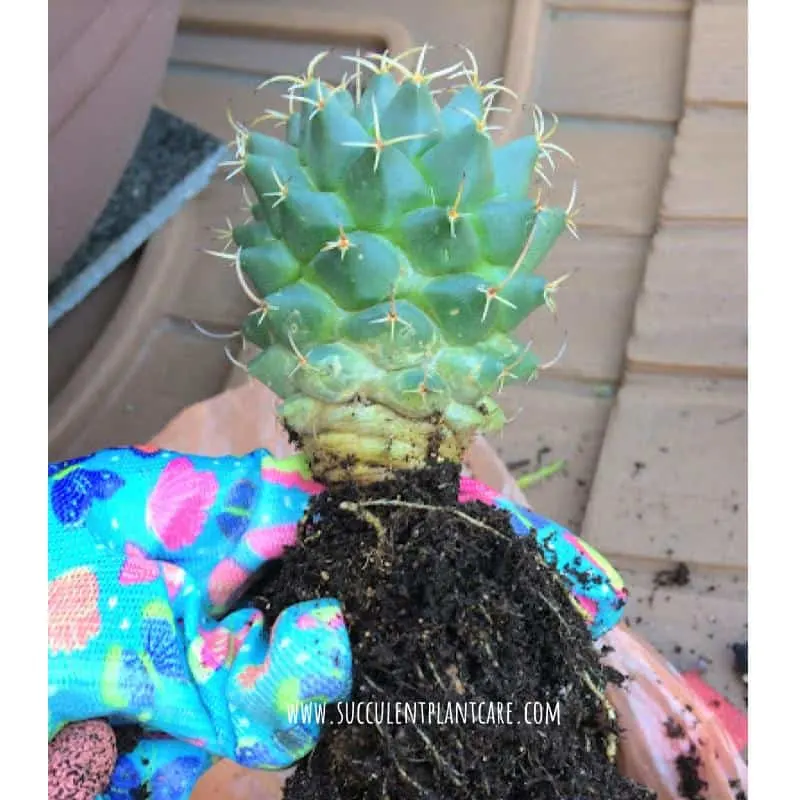
Soil Requirements
Mammillaria nejapensis requires well-draining, porous soil whether it is grown outdoors or indoors. You can use a standard cactus mix and combine it with perlite for extra drainage. You don’t need exact measurements. Just eyeball it to about 1:1 solution of cactus mix and perlite. You can also use a sandy mixture of coarse sand and cactus mix (1:1 solution). Or you can use a combination of these three materials (1:1:1 solution of cactus mix, perlite and coarse sand) for a porous soil mixture.
Check out my resource page for recommendations on soil and soil amendments to use.
This cactus is not a heavy feeder so fertilizing is not usually necessary especially if the potting mix is fresh. You can consider feeding to cactus during the active growing season during the spring and summer months. A cactus fertilizer blend diluted to about ¼ to ½ strength at least once a month during the growing season should be sufficient. You can check my resource page for my fertilizer recommendations.
To read more about this topic, click on my post “Best Soil and Fertilizer for Succulents and Cacti” for further details.
Watering Requirements
Mammillaria nejapensis does not require a lot of water but it does need enough to thrive. Natural rain should take care of your plant’s watering needs, but if it is not, you can water the plant once a week during the summer months or during really hot days. When the weather cools down during spring and fall seasons, water every two weeks or so.
As mentioned above, it is best to ease up on watering during winter. The soil should be kept quite dry during the cold winter months to encourage dormancy or a cooling period, which also encourages flowering. Watering once a month during winter is a good place to start.
A Mammillaria nejapensis that is growing indoors may not need to be watered as much as outdoor plants, especially if it is not exposed to a lot of sunlight. Before watering the plant, make sure that the potting soil is dry. The top inch of the soil needs to be dry before watering again.
If you are growing the Mammillaria nejapensis in a pot, it is better to choose a pot that has sufficient drainage holes to allow excess water to flow out of the pot. If you’re using a plate or saucer, make sure to empty it of any excess water that drains out of the pot so that the plant is not sitting in water.
Too much water and you run the risk of root rot, which is detrimental to the plant. Avoid misting the cactus. Give it a good drink and then leave it alone until the soil is dry. The top inch of the soil needs to feel dry before you water again.
If you need further help with gauging when to water your plants next, try using gadgets such as moisture meters to help detect the moisture level of the soil. Here are some of my moisture meter recommendations.
How to Propagate and Root a Mammillaria nejapensis
You can easily propagate a Mammillaria nejapensis from the offsets that develop in clusters that form around the base of a mature plant. Follow these steps to successfully propagate your cactus:
- Gently remove the offsets from the mature plant. Try to get as much of the roots as possible when removing the offsets.
- Place the offsets onto a piece of paper towel or in a dry location and allow them to dry out. This may take a few days depending on the humidity in your area.
- If there are any exposed areas, you will notice a scab-like growth forming over the cut area, which is called a callus. Once dry, you can dip the cut end in rooting hormone (rooting hormone is optional and not a must but can help speed up the rooting process).
- Prepare a pot or small container with rich, fast-draining cactus growing medium.
- Once the offsets have dried out, you can plant it. Plant the callus edge into the soil.
- The plant and growing medium must be kept warm and damp until new roots shoot from the offset, so place the container in a bright spot but away from direct sunlight. Allow the plant to establish itself over a few weeks before placing it in direct sunlight or planting it outside in the ground.
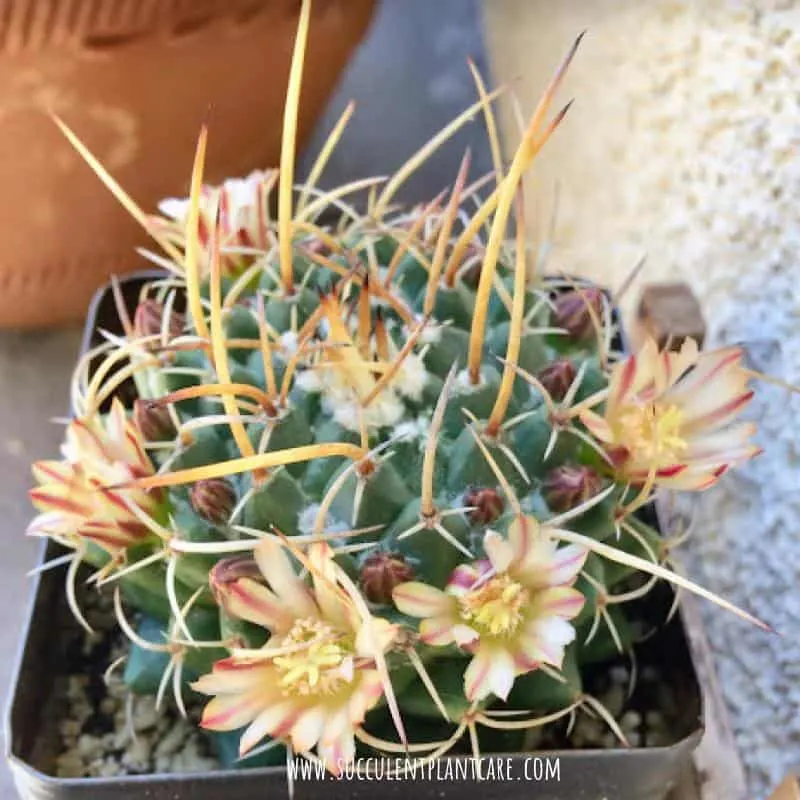
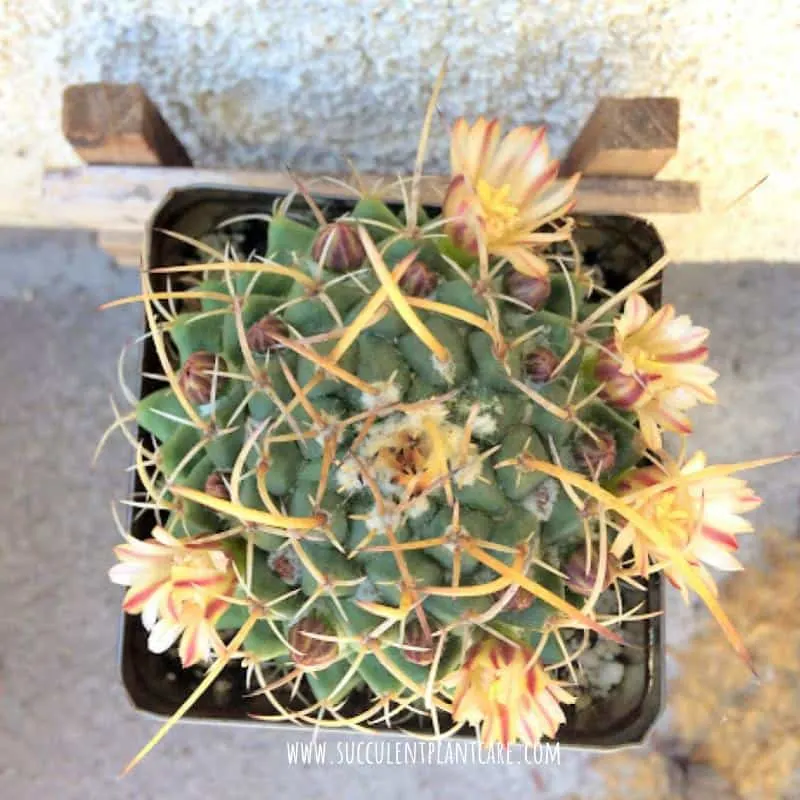
Mammillaria Nejapensis Blooms
The Mammillaria nejapensis usually blooms during the spring and summer months. The flowers are usually a combination of light pink, white and cream colors. The flowers can be quite numerous and can surround the top of the plant.
There are ways to encourage a Mammillaria nejapensis to bloom. But do keep in mind that not all cacti are ready to bloom, and some may not bloom at all depending on their environment.
Encouraging better flowering requires a cooling period in winter. You should also hold back on your watering schedule in winter. Providing the Mammillaria nejapensis with too much water during the colder months will deter flowering. If the plant remains damp or sits in water for too long, the plant will fail to flower completely.
After reducing water to an absolute minimum during winter and allowing the plant to be somewhat dormant, you can boost flowering in the spring and summer months. You can do this by increasing your watering steadily and feeding the plant with fertilizer.
Fertilizers are better applied at a quarter or half strength, about every two weeks during the growing season. A balanced blend of fertilizer or a fertilizer formulated for cacti and succulents diluted to half strength are both suitable. Here are some of my fertilizer recommendations suitable for cacti and succulents.
Flowering can start from late winter and go well into spring and summer.
Mammillaria Nejapensis Toxicity
Mammillaria nejapensis is considered non-toxic to both humans and pets. However, caution needs to be taken when handling this cactus at all times due to its sharp spines. Ingestion of the sharp spines can cause serious harm. If at any time you suspect poisoning, contact your local veterinarian immediately or the poison control center.
Mammillaria nejapensis ‘Mexican Pincushion’ is a popular cactus because it is quite easy to grow and it produces really pretty blooms. Consider these growing tips mentioned above to keep your Mammillaria nejapensis happy and healthy.
Here’s another plant you may find interesting: Mammillaria Hahniana ‘Old Lady Cactus’ Care and Propagation.
Wondering where to find a Mammillaria nejapensis ‘Mexican Pincushion’? Visit my resource page for recommendations on where to purchase these and other succulents and cacti online.
Pin this to save for later or share with others now!
